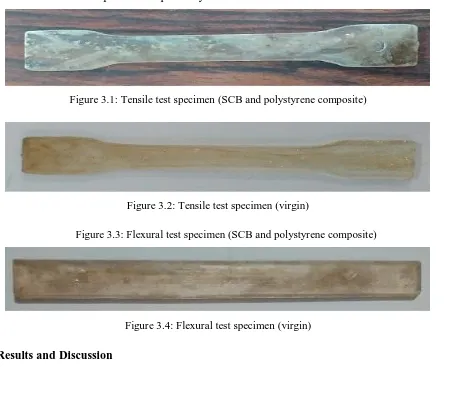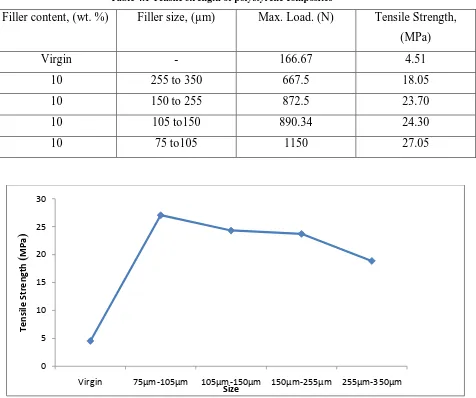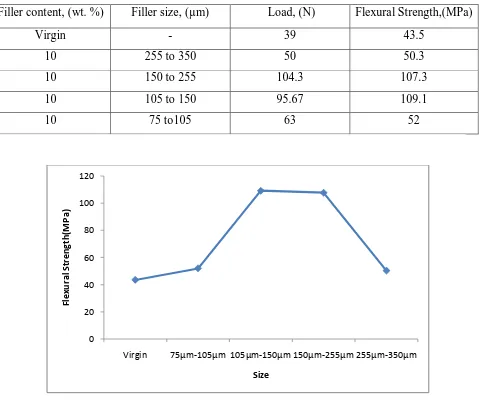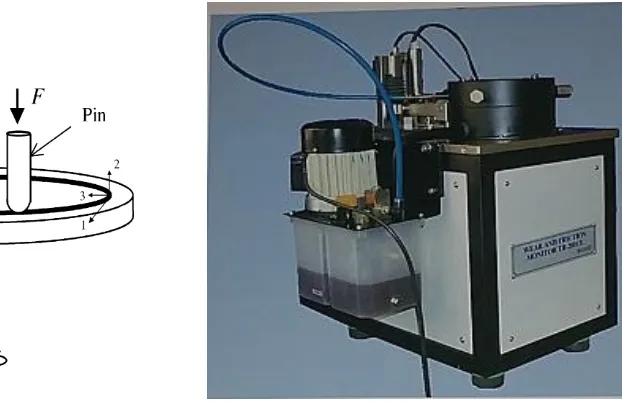GE-International Journal of Engineering Research
Vol. 4, Issue 3, March 2016 IF- 4.721 ISSN: (2321-1717) © Associated Asia Research Foundation (AARF) PublicationWebsite: www.aarf.asiaEmail : editor@aarf.asia , editoraarf@gmail.com
MECHANICAL BEHAVIOUR OF POLYSTYRENE REINFORCED
SUGARCANE BAGASSE COMPOSITES
Md. Aiyaz Ali Khan1, Mohd. Farhan Zafar2*, M. Arif Siddiqui3
1
PG Student, Department of Mechanical Engineering, Aligarh Muslim University, Aligarh, India
2
Research Scholar, Department of Mechanical Engineering, Aligarh Muslim University, Aligarh, India
3
Associate Professor, Department of Mechanical Engineering, Aligarh Muslim University, Aligarh, India
ABSTRACT
This paper presents the study on some of mechanical properties of PS-SCB composites. The SCB
was taken 10% by weight in all the synthesized PS-composites. Four different sizes namely,
75µm to 105µm, 105µm to 150µm, 150µm to 255µm and 255µm to 350µm of SCB particle were
used to synthesize the composites. The composites were prepared by in- situ polymerization
method. Hand operated injection moulding machine was used to make the test specimens. The
effect of SCB particle size on the mechanical properties of the PS-SCB powder composites was
studied
1. Introduction
Composites are combinations of two or more than two materials in which one of the materials is
reinforcing phase (fibers, sheets or particles) and the other is matrix phase (polymer, metal or
ceramic) [1]. The final properties of composites are function of the properties of the constituent
phases, their relative amounts, as well as the geometry of the dispersed phase [2]. The use of
natural fibers as reinforcements for composite has attracting more interest of industries. Fibers
reinforced polymer composites have many applications as class of structural materials because of
their ease of fabrication, relatively low cost and better mechanical properties compared to
polymer resins. For example in the automotive industry, the effort to reduce weight in order to
emission has led to the introduction of increasing amounts of plastics and composites materials
in place of the traditionally used steels [3]. Natural fibers reinforced polymer composites
represent one of today’s fastest growing industries. These fibers present a potential alternative in
reinforced composites because of growing environmental awareness and legislated requirements
compared to synthetic fibers such as carbon and glass [4]. Over the last few years, a number of
researchers have been involved in investigating the utilization of natural fibers as load bearing
constituents in composite materials. The use of such materials in composites has increased due to
their relative cheapness, their ability to recycle and for the fact that they can compete well in
terms of strength to weight ratio of material [5]
In this study we have used Sugarcane bagasse (SCB) as filler material. Bagasse is the fibrous
residue which remains after sugarcane stalks are crushed to extract their juice. It is mainly used
as a burning raw material in the sugar mill furnaces. The low caloric value of bagasse makes it a
low efficient fuel. Also, the sugarcane mill management encounters problems of regulating the
clean air, due to the quality of the smoke released in the atmosphere.
Sugarcane bagasse (SCB) wastes are chosen as an good raw material in manufacturing new
products because of its low fabricating costs and high quality green end material. It is ideal due
to the fact that it is easily available, given the extensive sugarcane cultivation making its supply
constant and stable [5].
2. Materials and Equipment
1. Sugarcane bagasse (SCB): We obtained the sugarcane bagasse from Jamalpur, Aligarh, UP
[image:2.612.71.567.477.588.2](India) to use as a filler material.
Figure 1.1 Formation of Bagasse composite
3. NaOH of N/10
4. Acetone
5. Benzoyl peroxide (BPO)
6. Glassware and equipment
3. Experimental Procedures
Sugarcane bagasse (SCB) particle was used as filler material. The SCB was first cleaned to
remove contaminant and then dried for 5 days in sunlight. After drying, the SCB was ground in a
food processor to obtain filler powder/particle. The fillers then passed through sieves of different
sizes to get the required filler sizes. In the present study four different sizes of the filler powder
i.e. 75µm to 105µm, 105µm to 150µm, 150µm to 225µm and 225µm to 350µm were used. The
weight% of sugarcane bagasse filler of each type was kept constant which was equal to 10% of
weight of styrene.
3.1 Washing of styrene
Styrene monomer is taken into separating funnel and shaken with N/10 solution of NaOH in
water. This method is suitable for water insoluble monomer. The inhibitor reacts with alkali and
the reaction product, being water soluble, comes out of the monomer phases and can be removed
along with the aqueous phase. After through shaking, the NaOH/styrene solution is made still for
about 2 minutes to separate out the monomer and alkali from the solution. The alkali solution is
removed from the separating funnel. Washing with alkali is repeated twice to obtain pure styrene
in this work.
3.2 Synthesis of polystyrene composites by in-situ polymerization
Through literature it has found that 0.011 g BPO is required for 5.5 ml of monomer. Hence in
this case 1.0g of BPO is required for 500ml of monomer.
Synthesis of polymer composites by in-situ polymerization basically involved the dispersion of
filler in styrene followed by free-radical polymerization initiated by the addition of benzoyl
peroxide. Styrene monomer containing the desired amount of filler was mechanically mixed by
stirrer for 30 minutes at room temperature in order to obtain better dispersion. The required
quantity of benzoyl peroxide was then added to the mixture to initiate the polymerization which
took place at 95°C at a constant speed (650 rpm) of stirrer in each case for approximately one
3.3 Sample Preparation.
The composites obtained at the end of polymerization were kept in an oven at 85°C for 2-3 days
to complete polymerization and remove the remaining moisture and liquid styrene. Then the
products were ground and subsequently the test specimens were prepared using a full ounce hand
operated injection molding machine. The ASTM D638 and ASTM D790 Standards are used for
tensile and flexural test specimen respectively.
[image:4.612.88.541.152.545.2]Figure 3.1: Tensile test specimen (SCB and polystyrene composite)
Figure 3.2: Tensile test specimen (virgin)
Figure 3.3: Flexural test specimen (SCB and polystyrene composite)
Figure 3.4: Flexural test specimen (virgin)
4. Results and Discussion
4.1 Tensile test
Tensile test was performed on UTM (universal testing machine) having maximum load of 5kN.
The test was carried out at speed of 2mm/min at atmospheric condition (25 0C). The size of the
Table 4.1 Tensile strength of polystyrene composites
Filler content, (wt. %) Filler size, (µm) Max. Load. (N) Tensile Strength,
(MPa)
Virgin - 166.67 4.51
10 255 to 350 667.5 18.05
10 150 to 255 872.5 23.70
10 105 to150 890.34 24.30
10 75 to105 1150 27.05
Figure 4.1: Effect of fillers size on tensile strength of synthesized polystyrene composites.
Table 4.1 shows the effect of particle size on the tensile strength of the SCB-PS composites. It is
observed that addition of 10% filler of all the four different sizes is acceptable and it may be use.
Addition of 10% filler drastically improves the tensile strength as compared to virgin
polystyrene. The tensile strength increases as we decrease the size of the fillers. The tensile
strength is maximum in SCB-PS composites of having filler particle size 75µm to 107µm. The
maximum tensile strength comes out to be 27.05MPa. This may be due to the better dispersion
in all filler size used in this study.
4.2 Flexural strength test
Flexural strength is the ability of the material to withstand bending forces applied perpendicular
to its longitudinal axis. Test sample for flexural test was 127.0mm x 12.7mm x 3.2mm in size. 0 5 10 15 20 25 30
Virgin 75µm-105µm 105µm-150µm 150µm-255µm 255µm-350µm
Here three point loading system was used. The specimens of above dimension were put on two
[image:6.612.76.555.90.497.2]supports and were loaded by means of a loading nose midway between the supports.
Table 4.2 Flexural strength of polystyrene composites
Filler content, (wt. %) Filler size, (µm) Load, (N) Flexural Strength,(MPa)
Virgin - 39 43.5
10 255 to 350 50 50.3
10 150 to 255 104.3 107.3
10 105 to 150 95.67 109.1
10 75 to105 63 52
Figure 4.2: Effect of fillers size on flexural strength of polystyrene composites
In general, the addition of filler increases the flexural strength. The effect of particle size is
significant at a level of 105µm - 255µm of particle sizes. It may be due to more uniform
dispersion of filler.
4.3 Wear test.
Pin-on-disc test apparatus, of DUCOM Company Bangalore (India), was used to investigate the
dry sliding wear characteristics of the synthesized polystyrene composite specimens. Composites
were pressed against a rotating EN32 steel disc (hardness 65 HRC) of diameter 70mm and 0
20 40 60 80 100 120
Virgin 75µm-105µm 105µm-150µm 150µm-255µm 255µm-350µm
Fl
e
xu
ra
l S
tren
gt
h
(M
P
a)
to the specimen at a room temperature about 25oC. The speed of the rotating disc was kept
constant i.e. 455 rpm. The time for each sample was set for 4 minutes. Test results were reported
as weight loss in mg/min.
[image:7.612.176.487.118.319.2]Figure 4.3(a): Wear principle Figure 4.3(b): Wear testing machine
Table 4.3 Wear rate of polystyrene composites
Filler content
(wt. %) Filler Size(µm)
Wear rate (mg/min) at load
3kg 5kg 7kg
10 255 to 350 12.45 26.98 33.8
10 150 to 255 9.77 17.0425 23.66
10 105 to 150 8.062 13.5025 17.315
10 75 to105 3.60 9.72 17.127
[image:7.612.110.503.383.556.2]
Figure 4.4: Effect of fillers size on wear rate of polystyrene composites.
As shown in table the wear rate increases as applied load increases. It is due to increase in
friction between composite and the rotating disc. The wear rate decreases with addition of filler
irrespective of particle sizes. The effect of the particle size on the wear rate is significant
particularly at the level of 255 µm- 350 µm. the pattern is same for all the loads applied in wear
test.
Conclusion
Addition of filler particles improves the mechanical properties and as the size of the particle
decreases, tensile strength increases. Also with increase in filler size, flexural strength increases
upto a level and then decreases. Composite having filler size 105µm to 150µm gives a significant
increase in flexural strength. The effect of particle size on wear rate is significant. The lower the
particle size, the lesser would be the wear rate at all the loads studied.
References
[1]. Z. S. R. Parween Ali Khudhur Basim A. Khidhir Omer S Zaroog, “Fracture Toughness of Sugar Palm Fiber Reinforced Epoxy Composites,” Int. J. Sci. Res., vol. 2, no. 12, pp. 273–279, 2013.
[2]. S. Ahmad, T. Alam, A. Siddique, and A. H. Ansari, “Tensile Strength of Synthesized Polystyrene Composites,” vol. 4, no. 10, pp. 1038–1044, 2015.
[3]. E. Cerqueira, C. A. R. P. Baptista and D. R. Mulinari, “Mechanical behaviour of polypropylene reinforced sugarcane bagasse fibers composites,” Procedia Eng., vol. 10, pp.
0 10 20 30 40 50 60
Virgin 75-105 105-150 150-255 255-350
[4]. P.Souza, E. F. Rodrigues, J. M. C. Prêta, S. S. Goulart, and D. R. Mulinari, “Mechanical properties of HDPE/textile fibers composites,” Procedia Eng., vol. 10, pp. 2040–2045, 2011. [5]. A. Balaji, B. Karthikeyan, and C. S. Raj, “Bagasse Fiber – The Future Biocomposite
Material : A Review,” International Journal of ChemTech Research vol. 7, no. 01, pp. 223–233, 2015.




